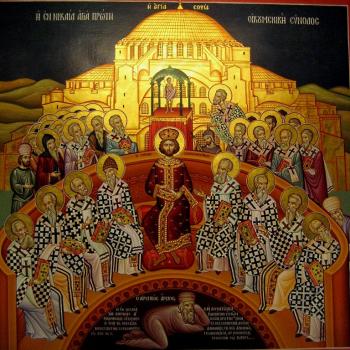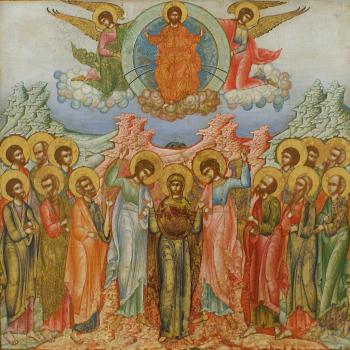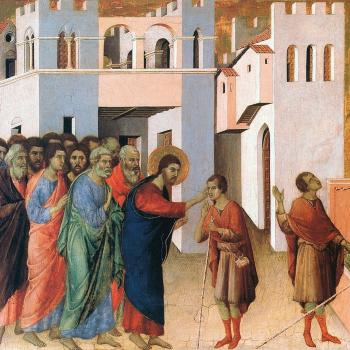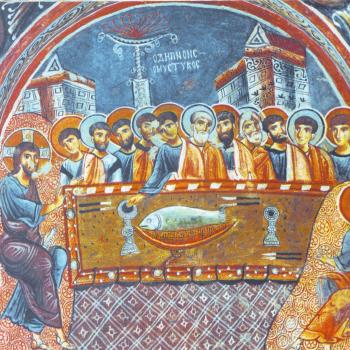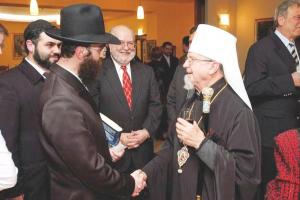
After the destruction of the Temple, and the expulsion of the Jews from Israel, we see the ascendency of Rabbinic Judaism and of Christianity, both of which could be seen as offering interpretative reactions to what they believed to be major apocalyptic events in world history. Both Jews and Christians recognized the Torah and the prophets (the Tanakh) as the authority which were to be accorded to them, and yet, the way each side interpreted the Mosaic Covenant and the history of the people of Israel became radically different as they found themselves drifting far apart from each other.[1]
Rabbinic Judaism focused on the Jewish people as a whole, and the kind of legacy and spiritual tradition which they could follow after the destruction of the Temple. While they focused on their own Jewish legacy, they did so with various considerations and reactions to the Gentiles; early Rabbinic sages were not always in agreement as to the relationship between the Gentiles with the God of Israel. Some were more critical, especially since Roman authorities were behind the demolition of the Temple, while others were far more inclusive, and believed that the Torah offered a way to see those outside of the Mosaic Covenant as still possessing a form of godliness.
Christian focused on how the Jewish history could be interpreted as leading to the coming of the messiah, and how that interpretation meant the authentic meaning of the Torah and the prophets continued in the world through Christian believers. For example, they interpreted the Temple symbolically, seeing that it pointed to Jesus, and that its proper mission was fulfilled in Jesus himself. In this way, the tragedy which happened to the Temple was interpreted as representing that its historical mission was fulfilled, making the building, nor the special rites used within it, as being no longer needed.
It is not hard to see that these rival interpretations of the Tanakh began with shared values, hopes, and fears; there was much which was shared by all sides, though as time went on, and the sides developed their rival interpretations further, they became more distinct and separate from each other, so much so it could be said that we could take a cue from the theory of evolution and suggest their division could be said to be religious speciation. The distinctions established rivalries, rivalries established bad blood from people from both sides, though, to be sure, there were many who seemed interested in being in the middle of these development. We find much of the literature in this period of growth, such as the so-called Sibylline Oracles, Merkabah mystical literature, and the like showing how these ideas were flowing to and from the distinct religious groups which developed alongside each other: all one has to do is read “3 Enoch” to note how Merkabah literature and Christian apocalypticism shared a common cosmological vision which allowed for an inter-religious dialogue to continue between the groups despite their rivalries.
What became a distinguishing mark between the different groups, beyond the theological differences found in those who accepted Jesus as messiah (and the teachings of the incarnation, the Trinity, and the like), is the way religious authority was recognized. This is not to say there was no common ground, as there were some forms of religious authority which could be found asserted by people from both sides of the religious divide, but as a whole, the question of religious authority became the question of who could interpret the Tanakh and who then had the right to dictate doctrine as well as to propose disciplines to be followed. Once the Temple and its priests no longer held power, it is obvious that others would and did come in to fill the void (though, to be sure, these others existed before the destruction of the Temple and were already beginning to emerge as rivals to the Temple and the religious structure centered around it).
In the Rabbinic tradition, we find three inter-related models of authority: that is, while one aspect or another might be emphasized by particular groups within the Rabbinic tradition, all of them would agree with that honor and authority should be given to Rabbinic sages. The question was what made someone a sage, and how the sages were to be ranked in hierarchical fashion. Three different responses could be seen: one was to suggest that authority became passed down along familial lines, emphasizing a clear and consistent patriarchal system, though with the expectation that those who held the position of patriarch would be a scholar in their own right. The second response was to suggest those who were the best scholars, those who knew and understood the Torah in its written and oral forms the best should hold the greatest authority: debates would therefore be a way to determine the ranking of scholars. The third line of thought was mystical, looking to holy men who possessed a clear line of connection with God, as holding the greatest form of authority, though normally this third group was rejected by the other two unless such a figure was also one of their own. [2]
In Christianity, we see scholarship and knowledge as being important, but not necessarily important for the sake of determining who would be a religious authority. Instead, various forms of charism, which went beyond family lineage or what people knew from mere study, held the day. Either some form of orders through the laying on of hands and apostolic succession, or some idea of spiritual holiness which turned various people into prophetic oracles, or some form of gnostic holiness became the general means by which religious authority was asserted. For the first group, we see the general ecclesiastical tradition forming bishoprics with charismatic instead of familial lineages forming the basis of Christian authority. For the second group, we have various spiritual movements, like the Montanists, who looked for and desired a continuous line of revelation through the Holy Spirit, allowing for people who claim to be possessed by the Spirit to become leaders of various sects. Finally, the third group was composed of many Gnostic sects, of which most of the first two groups found themselves united in fighting and rejecting, although each allowing some level of spiritual mysticism or gnosis to be acceptable within their tradition as long as that gnosis remained in line with the teachings and practices promoted by authentic authorities.
What is interesting to note is that the Rabbinic tradition offered a more scholarly approach to authority, even when patriarchal lines of authority were established, than the Christian tradition, which probably explains how and why Christian history is riddled with uneducated priests and bishops. Christianity embraced a more charismatic approach, because it viewed the authority as coming from God, with people being used as instrument of God’s authority instead of people establishing themselves as authorities by their own merits. Christianity, therefore, could be seen as a vital continuation and development of the third form of Jewish authority: in fact, this makes sense because Christian authorities would have to argue against and contradict the Jewish scholarly tradition in order to promote their own theological interpretation. But, because of their contact with the Jewish tradition, indeed, coming from it, the Christian tradition still recognized the value of the scholarly tradition and its need, which is how and why another kind of authority developed, that of an academic authority, which has constantly found itself in conflict with the charismatic authority of the church’s traditional leaders.[3] Theology is, by its standards, less charismatic in nature (though not opposed to such charism), making it more likely to investigate and debate what is established by those who claim some sort of charism. This is why the study of theology often leads to inter-Christian controversy and debate between theologians and other Christian leaders: theologians address questions in regards the limits available to an academic scholarly study, while Christian leaders find themselves not so limited because of their belief in the power of their charism to help direct and smooth out their deficiencies.
It is invaluable for Christians to remember their connection with the Jews. The religious traditions might have become distinct, and with it, demonstrated rival forms of authority as a result of their interpretation of history, but it is often important for Christians to reconsider what was lost as a result of that division. They do not have to agree with everything found within the Jewish tradition, but they should appreciate it, and understand it as a logical and proper development of the common heritage Christians have with the Jews, albeit one which follows after differing premises. Christians should welcome the various interpretations Jewish tradition gives to the Torah, indeed to the Tanakh, especially because Scripture is shown by them to be interpreted in a diverse number of ways which do not necessarily preclude what Christians believe. Christians might want to emphasize interpretation over others, in part because of their differing hermeneutic with Christ at the center of that hermeneutic, but that should not lead to a rejection of key insights found in the Rabbinic tradition. They can even recognize that the Rabbinic tradition and its scholarly memory of the Jewish encounter with God offers much which should be accepted. That is Christians can, like Christ, draw from Jacob’s well and be refreshed. It is good. It is useful. It is worthy of respect.[4]
[1] As the Acts of the Apostles indicates, Jewish believers continued to have a part in the synagogue. When the Temple was destroyed, many Jewish believers found themselves joining in to exclusively Christian circles, as more and more Christians came from a Gentile background and deemphasized the need to continue associations with Jewish peers.
[2] See, for example, Jeffrey L. Rubenstein, trans. and intr., Rabbinic Stories (New York: Paulist Press, 2002), 104-8. By 700-1100 CE heads of Rabbinic Academies were mostly chosen through familial lineage, with the stories in the Talmud suggesting this was beginning much earlier. Nonetheless, because some Rabbis did try to assert authority through knowledge, and knowledge was something that gave one some level of authority, it is clear scholarship itself could and did establish a level of authority. Hence, patriarchal lineages became important, following the precedence with priestly lines in other times, but there was some room for scholars to establish lines of their own. The story of Rabban Shimon b. Gamaliel, an authority via lineage, being contested by scholars, R. Meir and R. Natan, demonstrates not only this internal struggle for power, but the way that power was to be used by those who had it to keep it. Gamaliel wanted special honors for patriarchal authority over and beyond those of other scholars; when he won the debate, he not only helped further that power and authority, but he undermined Meir, Natan, and those like them by ordering Meir and Natan out of the academy, reinforcing the status of patriarchal lineages over mere scholars. For the third group, we can think of leaders like Honi the Circle Drawer, John the Baptist, and even Jesus himself.
[3] We see this with the Catechetical School of Alexandria, and the conflict Origen would have with the Patriarch of Alexandria. This rivalry of scholastic authority over charismatic authority would emerge many times in Christian history. When charismatic authority is dismissed, then scholastic authority could and did become an authority of its own. Perhaps this is why Vladimir Solovyov saw within Protestantism a draw towards theological scholars as being a key part of their distinction from the rest of Christendom.
[4] This is why those like Reuchlin, who defend the Jewish tradition, including its mystical tradition with the Kabbalah, represent an authentic Christian interaction with Judaism, with a willingness not only to protect the Jewish legacy but to sit down and learn from the Jews.
Stay in touch! Like A Little Bit of Nothing on Facebook.
If you have liked what you read, please consider sharing it with your friends and family!




